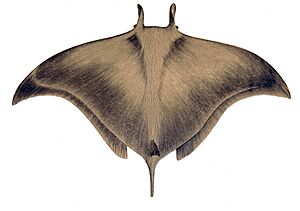Devil fish facts for kids
Quick facts for kids Devil fish |
|
|---|---|
 |
|
| Conservation status | |
| Scientific classification | |
| Synonyms | |
|
The devil fish or giant devil ray (Mobula mobular) is a species of ray in the family Mobulidae. It is currently listed as endangered, mostly due to bycatch mortality in unrelated fisheries.
Description
The devil fish is larger than its close relative the lesser devil ray. It grows to a length of disk 3.5 metres (11 ft), making it one of the largest rays. It possesses a spiny tail. The devil fish is the third largest species in the genus Mobula, after the oceanic and reef manta rays. It is the only mobulid species that lives in the Mediterranean Sea. The species has been observed to have a maximum recorded length of disk width of 5.2 meters (roughly 17 feet). However, those data are unreliable and are allegedly misunderstood as Giant oceanic Manta Rays that have strayed into the Mediterranean. It is also considered to be the only Devil fish with a tail spine. The species is also considered endangered given its decreasing population density.
Distribution and habitat
The Devil fish is most common in the Mediterranean Sea. It is also found in the Eastern Atlantic Ocean, off the southwest coast of Ireland and south of Portugal, as well as in the central and western Pacific Ocean. In the Mediterranean Sea, the species has a basin-wide distribution and is most frequent in the eastern Mediterranean and the Adriatic Sea. The large aggregations observed in the Levantine basin could signal an important mating area.
Devil fish inhabit offshore areas to the neritic zone, their range as deep as several thousand meters. They are typically observed in small clusters, and may occasionally form larger groups.
Giant devil rays are usually seen in deep coastal waters but are occasionally seen in shallow waters. In a tagging experiment conducted by the Italian National Institute for Environmental Protection and Research (ISPRA), three giant devil rays were tagged and their depth was observed throughout different times of the day. The rays reached a maximum depth of 600–700 meters (1960–2300 feet) but mostly spent their time between 0 and 50 meters (0 and 165 feet); they prefer warmer waters with a temperature between 20 °C and 29 °C (68 °F and 84 °F). The giant devil rays also deep dive at random times, instances not correlated to the time of day unlike how other species deep dive at specific times of day. In other observations studying ray abundance and habitat, giant devil rays were observed alone and occasionally in groups with a maximum of 18 rays. The same study also emphasizes that the rays undergo a species migration across the Mediterranean Sea with the seasons, taking advantage of warm, highly productive waters.
Ecology
The average lifespan of a giant devil ray is 20 years. It is an epipelagic species. It has a very low reproductive capac ity. This means that the species gives birth to a single offspring at unknown intervals. The species is ovoviviparous: the young hatch from their eggs inside the mother's body and emerge later when they are more fully grown. The disc width of the pups born at the Osaka Aquarium was 1.03 m (3 ft 5 in).
It can be predicted that at the rate that its population is declining now, the population will decline by at least 50% in the next 60 years. This is due to a number of threats including the poor likelihood of recovering from declining populations.
Devil rays feed on planktonic crustaceans and small schooling fish, which are funneled into the mouth with cephalic flaps. When these flaps are rolled up, they look like horns, giving the animal a "devil-like" silhouette. It mostly eats euphausiid shrimp (Meganyctiphanes norvegica) and small mesopelagic and clupeid fishes.
Conservation status
The devil fish has a limited range and a low rate of reproduction. As a result, it is sensitive to environmental changes. Its population trend is decreasing. Most of the information on the giant devil ray has been gathered through bycatch data because the species has a high bycatch mortality. Giant devil ray mortalities are mostly reported as bycatch from swordfish nets, and occasionally reported as bycatch from longlines, purse seines, trawls, trammel nets, and tuna traps. There are many threats against the giant devil ray such as fishing, resource harvesting (being taken as bycatch in different fisheries), industrial garbage, and solid waste. The main threats to this species come from pollution in the Mediterranean and bycatch capture in various fishing equipment including trawls, tuna traps, and dragnets meant for swordfish. All species of the genus Mobula have been targeted by recreational and commercial fisheries for centuries. Fisheries in Gaza and Egypt are reported to catch giant devil rays for local consumption, and they are reported as bycatch in various places including the Indian Ocean and Atlantic Ocean.
The 2004 IUCN Red List listed the devil fish as a vulnerable species. It was reclassified as endangered in 2006 due to low population resilience coupled with continued high bycatch mortality. In June 2018 the New Zealand Department of Conservation classified the devil fish as "Data Deficient" with the qualifier "Secure Overseas" under the New Zealand Threat Classification System. Off of the Adriatic Sea, the giant devil ray is legally protected in Italy and Croatia. Fishing, transportation, landing, and trade of the giant devil ray is forbidden in Albania. The giant devil ray is also protected under the Bern and Barcelona conventions.



